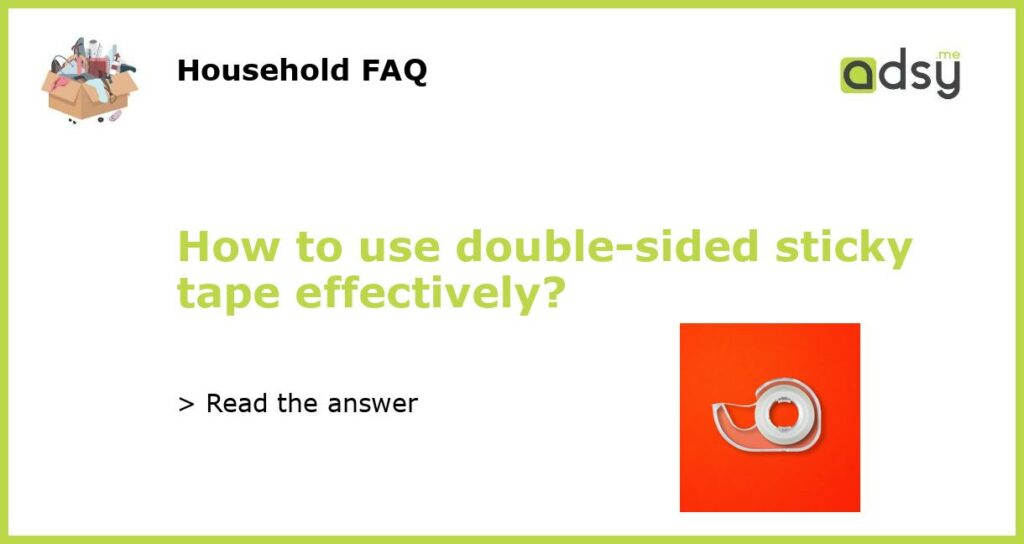Understanding Double-Sided Sticky Tape
Before we delve into the effective use of double-sided sticky tape, it’s important to understand what it is and how it works. Double-sided sticky tape is a versatile adhesive product that is coated with an adhesive on both sides. It is commonly used to stick two surfaces together, providing a strong and lasting bond.
Choosing the Right Double-Sided Sticky Tape
Not all double-sided sticky tapes are created equal, and choosing the right one for your specific needs is crucial for effective usage. There are several factors to consider when selecting the appropriate tape:
- Adhesive strength: Ensure that the tape has the right level of adhesive strength for the objects or materials you intend to stick together.
- Surface compatibility: Different tapes work better on certain surfaces, so be sure to consider the materials you’ll be working with.
- Application requirements: Determine whether you need a tape that is heat resistant, waterproof, or suitable for outdoor use.
By taking these factors into account, you can choose a double-sided sticky tape that is best suited for your specific application.
Preparing the Surfaces for Bonding
Before using double-sided sticky tape, it’s important to properly prepare the surfaces you intend to bond. Here are a few steps to follow:
- Clean the surfaces: Make sure the surfaces are free of dirt, dust, and any other contaminants that may hinder the tape’s adhesion. Use a clean cloth and a mild cleaning solution, if necessary.
- Dry the surfaces: Ensure that the surfaces are completely dry before applying the tape. Moisture can weaken the adhesive bond.
- Smooth out any rough surfaces: If the surfaces are uneven or rough, consider sanding or smoothing them out to achieve a more secure bond.
By properly preparing the surfaces, you’ll increase the effectiveness of the double-sided sticky tape and enhance its bonding capabilities.
Applying the Double-Sided Sticky Tape
When it comes to applying double-sided sticky tape effectively, there are a few key steps to follow:
- Measure and cut the tape: Determine the length of tape you’ll need and cut it to the desired size. Remember to remove the protective liner from both sides of the tape.
- Position the tape: Carefully place one side of the tape onto one of the surfaces, ensuring proper alignment. If necessary, use a ruler or a straight edge to keep the tape straight and avoid any wrinkles or folds.
- Secure the bond: Press down firmly on the tape to ensure a strong bond. Applying even pressure along the entire length of the tape will maximize its adhesive capabilities.
- Join the surfaces: Once one side of the tape is securely in place, align the second surface and press it firmly against the exposed side of the tape. Apply even pressure to ensure a secure bond.
Following these steps will help you achieve an effective and long-lasting bond using double-sided sticky tape.
Tips for Enhancing Adhesion
To further enhance the effectiveness of double-sided sticky tape, consider the following tips:
- Allow for proper curing: Give the adhesive enough time to fully cure before subjecting the bond to any stress or load. Refer to the manufacturer’s guidelines for specific curing times.
- Avoid extreme temperatures: Extreme heat or cold can affect the adhesive properties of the tape. Avoid exposing the bond to temperatures outside the recommended range.
- Avoid excessive weight or tension: Double-sided sticky tape has its limits, so avoid applying excessive weight or tension to the bond. Consider additional reinforcement if needed.
- Replace old tape: Over time, the adhesive properties of double-sided sticky tape may deteriorate. If you notice any signs of weakening or failure, it’s important to replace the tape to maintain an effective bond.
By following these tips, you can use double-sided sticky tape more effectively and ensure a strong and long-lasting bond for your projects.






